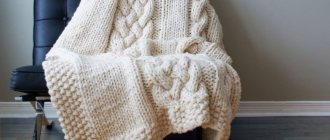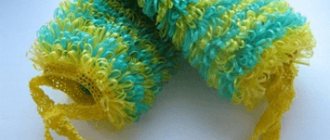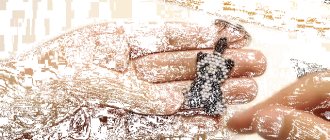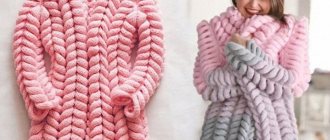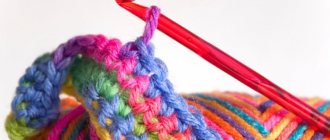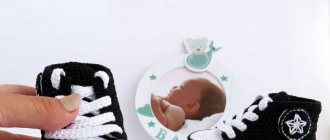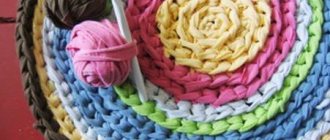Yarn for washcloths
Both natural and artificial materials can be used for knitting washcloths. Natural washcloths are healthier, but they last much less, since they contain pathogenic organisms and can rot and mold. Their maximum service life is 1 month, after which the washcloth should be replaced with a new one.
Washcloths made from synthetic threads last much longer; it is recommended to use them for no more than 3 months, although their strength can be maintained for more than a year:
- Cotton and linen. Cotton washcloths are soft and suitable for children and people with very delicate and sensitive skin or those suffering from skin diseases. Linen washcloths have a beneficial effect on blood circulation.
- Polypropylene. It is considered a fairly strong synthetic material. Washcloths made from such threads lather well and are able to perfectly remove sweat, fat and dead skin cells.
- Leg-split. Polypropylene twine, which is very durable, is more suitable for washcloths. But natural ones are also suitable: jute or linen.
- Sisal. Obtained from the leaves of Agave sisalana. This material is more suitable for flat massage sponges that work well on rough skin.
- Plastic bags. Knitting washcloths from this material is considered a utilitarian craft that is beneficial and helps to get rid of unnecessary things. Washcloths knitted from bags are suitable for people with delicate and sensitive skin. It is not recommended to use them when using scrubs.
- Nylon tights. Fragile women's products quickly break down and have to be replaced frequently. Needlewomen do not throw them away, but use them for knitting washcloths, cutting them into strips 3-4 cm wide. It is better if the washcloths made from tights are flat.
- Sock additive. The material is quite durable, suitable for any washcloths, even those intended for washing dishes.
- Viscose. Washcloths made from artificial fiber, which is made from pine or bamboo wood, are quite durable and beautiful.
- Acrylic. Sponges made of acrylic, a synthetic polymer fiber made from petroleum products, are very durable and reliable.
- Bags. If you don’t have yarn on hand, you can unravel the used bag. Pre-washed sugar and flour bags are suitable. The washcloth will be durable and beautiful.
Crochet hooks are selected according to the threads used. It is desirable that they have rounded rather than pointed heads.
Ready washcloths 10 min. should be kept in boiling water. They will become more pleasant and lather better.
What kind of yarn is there?
The technique of knitting washcloths is simple. Women who know how to hold a hook and knitting needles will do it easily. There is also a method of knot weaving, close to macrame. If the size and style are chosen, then the next step is to decide on the material. And then your eyes widen, what kind of yarn does not exist! Take natural fibers:
- Jute is a textile fiber, material for twine and burlap. The strands are hard, good material for washcloths.
- Manila fiber from abaca (spinning banana).
- Hemp is the fiber from the stems of hemp.
- Bast is a deep layer of linden or willow bark, a wonderful material that releases phytoncides beneficial to health, but unfortunately it is short-lived.
- Loofah - “loofah gourd” or “crazy cucumber”, the dried and peeled core itself is a ready-made loofah, but if you are not satisfied with the shape, you can comb out the fiber for spinning.
- Sisal is a coarse agave fiber, a guest from South America.
- Ramie is a Chinese nettle, our Russian one is no worse, you just need to squeeze the stems correctly, dry them and fluff them into fibers. Enthusiasts do the same with rhubarb petioles.
- Cotton yarn is a wonderful material, but not very practical for washcloths.
- Flax, flax fiber is a product of processing flax straw.
- Wool is an excellent yarn for washcloths, the coarser the better.
- Steel is most often found in the form of lace wire scourers or twisted springy strips, and is primarily used for cleaning utensils.
- Exotic materials such as birch bark and stone wool (granite, basalt).
Natural materials are good for everyone, but in addition to fragility, there are other disadvantages: rarity on the Russian market and, accordingly, high cost (with the exception of jute and flax), a narrow range of threads and yarn. They are susceptible to rotting and mold, and colonies of pathogenic microorganisms easily develop on them. This means that additional efforts are required for disinfection, washing, and drying.
How to crochet hard and soft
Crocheting a washcloth can be difficult for beginners, but step-by-step instructions will help you get the job done. The main thing is the ability to knit a lush column.
For a double-sided washcloth, a No. 4 hook and any polypropylene yarn are suitable. The future washcloth can be either plain or beautiful multi-colored.
The sides turn out to be different - one is hard, knitted lengthwise, and the other soft, knitted across:
- 1st step – chain. The length of the future washcloth will depend on the number of loops cast on.
- The 1st and 2nd rows consist of sc.
- 3rd row. If the washcloth is multi-colored, then first an air loop is knitted with 2 threads, followed by 2 sc, then a fluffy stitch. It is untied from the originally knitted chain.
To form a fluffy column, you should knit 5 dc and secure them with an air loop. Next come 3 sc and knitting the next lush column. This continues until the row ends.
- 4 row. The first loop is knitted with an air loop, then the sc is knitted into the loops of the previous row. For a multi-colored washcloth, the last loop is knitted with 2 threads at once.
- The 5th row is knitted again with a thread of the first color, chain stitch as well. Next comes the alternation of 3 sc and a lush column, which is knitted from the loop of the last knitted row of the same color.
- Row 6 is knitted like row 4.
- 7th row. If the washcloth is knitted in different colors, a thread of the third color is introduced into the work and row 5 is repeated.
- Row 8 is similar to row 4.
- Continue knitting until the required width of the washcloth is reached.
To knit the soft side, you need to start working from the side of the resulting fabric. This side is knitted in the same way as the previous one, but the fluffy stitches are made from three dcs, not five. And they will alternate not with 3 sc, but with 2. Having finished the 2nd side, both halves are folded and either crocheted around the perimeter or sewn from the inside out. At the request of the knitter.
If the halves were sewn together, then the result is a pipe and the holes still need to be crocheted and then the handles are tied. You can sew cotton braid as handles. To make it soft, scald the washcloth with boiling water.
With extended loops
Beginner knitters should start with a flat washcloth, which will have elongated stitches on only one side. Due to these loops it will turn out to be more voluminous. They can be in every row, after 1, or even after 2 rows. In order to save yarn, the loops can be diluted with single crochets.
A crocheted washcloth for beginners (step-by-step instructions help you understand the sequence of work) of the volumetric type is more complex, but the proposed drawings will help you master it too.
For a voluminous washcloth in the form of a hollow pipe, you will need about 300 m of polypropylene and a hook No. 3. Like most washcloths, knitting begins by closing air loops into a ring (there should be 40 of them here).
Since it is knitted in the round, the transition to the next row is carried out through air loops that form a rise. Do the same when knitting other washcloths.
7-8 rows (more or less possible) are knitted. Dc is also possible. Then comes the knitting of the elongated loops (the knitting technique is shown in the pictures below). Loops can remain both in front of the work and behind it. The elongated loops are knitted to the desired length. The work ends with the same number of rows of sc (or dc) as it began.
|
To knit handles, 30-40 air loops are made, preferably in 2 threads. The height of the loops can be made very different; the volume and “fluffiness” of the future washcloth depends on it.
Master classes on knitting washcloths
Manual labor has always been highly valued. It is for this reason that crocheted washcloths are in particular demand. There are a lot of master classes on the Internet, so even an inexperienced needlewoman can make such an accessory on her own.
Kese washcloth
Craftswomen who often crochet washcloths know firsthand such an interesting product. This accessory is often used in hamam , that is, a Turkish bath. The washcloth provides gentle cleansing of the skin without the use of any gels or other products. The product looks like a mitten made from natural materials. For delicate and sensitive skin, silk or plant fibers are used , and for rough areas, a thing made from goat or sheep wool is suitable.
You can make kese with your own hands. Those who don't know how to knit a loofah should first select the materials. So, you will need sheep wool . If it is not there, then you can take another yarn that suits its texture and stiffness. The main thing is that she calmly tolerates contact with water.
Step-by-step work:
- First of all, you need to tie the handle. To do this, you need to make 40 air loops in 2 threads.
- Starting from the third loop, you need to knit until the end with double crochets. This will be one of the handles.
- You should cast on 10 loops without cutting the thread, and then carefully connect both edges of the handle.
- For the main part, 3 rows of 16 columns are made. Then you need to put the thread on your index finger so that during the knitting process you get an elongated loop. To do this, insert the hook into the column of the bottom row and carefully pull out the thread without making a yarn over.
- Next you need to knit 50 rows, alternating elongated and regular loops so that they are staggered. Thanks to this, the washcloth will not stretch during use.
- At the end you need to knit 3 rows of 16 single crochets.
- Separately, another chain of 40 air loops is performed, which is connected to the main fabric using 3 single crochets.
The finished washcloth must be doused with boiling water before use.
Long washcloth
The easiest option for crocheting washcloths for beginners is to create a fabric with elongated loops. To do this, you need to make a chain and connect it using a half-column. The number of loops depends on the desired volume of the future washcloth. Most often, experienced knitters cast on 30-45 chain stitches . After this, you need to knit 7 rows with single crochets, and then start knitting the elongated loops, which should remain behind the fabric.
When the main part is ready, you need to knit two chains of 20 loops. They close into a ring and are tied to the edges of the canvas. This creates handles whose length can be adjusted . After this, all that remains is to turn the product inside out and straighten the elongated loops.
Washcloth-mitten
This washcloth is knitted using the same principles as regular mittens. The main difficulty, which not all beginning craftswomen are able to cope with, is knitting the thumb . If such a detail causes serious difficulties, then you can skip it.
First you need to cast on a chain of 30 loops, and if the hand of the future owner of the accessory is small, then 20-25 loops will be enough. The chain is connected into a ring, and then they begin to knit single crochets in a circle. When moving to the next row, you need to knit an air loop. When the canvas matches the size of your hand, it needs to be secured on top. To do this, the edges are connected with single crochets. Next, it remains to fasten the thread.
Baby washcloths
Many young mothers are interested in crocheting washcloths for children. Such products are very easy to make. To make them you will need soft yarn , preferably linen, and a hook that is not too thick.
Drop sponge
- You need to make a chain of 50 loops, and then knit 5 rows with single crochets. There is no need to cut the thread after this.
- The resulting ribbon is rolled up, placing one end over the other. One of the ends of the tape is inserted into the resulting ring.
- After this, the edges must be carefully sewn.
To understand how to properly assemble such a washcloth, just look at the principle of attaching the simplest commercial washcloths. To make the finished product interesting, you should use multi-colored threads.
Ladybug shaped washcloth
- This product consists of several parts: bottom, top and dots. Red yarn is used to create the top part. A ring is created from 5 loops, into which 10 single crochets are knitted. Then you need to perform approximately 20 rows, increasing 3 loops in each of them.
- Another circle is prepared in the same way for the lower part. However, now you need to use pink thread and add not 3, but 6 columns.
- When the circle is ready, you need to tie a chain of 5 loops and secure it to the last row. This will create the base for the head. 6 rows are knitted into this arc, each of which should have 5 single crochets.
- When the head is ready, you need to start working on the paws. To do this, you need to determine on the top part where the 6 legs will be located. To complete them, you need to tie a chain of 10 loops, which are tied with single crochets on both sides.
- Black yarn is used for the dots. It is necessary to make a chain of 4 loops, connect its edges and tie it with 2-3 rows of single crochets. The finished dots are sewn to the red circle.
- The last stage is stitching together large parts. In this case, you need to leave a small hole for a child's hand.
Tying a washcloth yourself is not difficult at all. It’s enough to show a little imagination and set aside a few free evenings.
Double crochets
Almost when knitting any washcloth, you will encounter double crochets.
A very simple washcloth can be made using only them. You will need synthetic twine, hook number 3, acrylic or viscose.
It is recommended to knit in 2 threads. The washcloth will be quite hard.
Knitting step by step:
- From the collected 40 air loops, dc are knitted.
- Knitting proceeds in a spiral to the required width.
- On turns, 3 dc are knitted into one loop, this will help avoid pulling.
- The outer row is knitted in the opposite direction. Having knitted one of the sides, a chain for the handle is knitted, then knitting goes on the other side and ends with knitting the second handle.
- After attaching the handle, the thread is cut and secured.
With a "bump" pattern
To knit such a beautiful washcloth, you should prepare hook No. 5, with which you first knit a chain of 36 loops, which is subsequently closed into a ring.
Knitting step by step:
- The 1st row is knitted with single crochets.
- 2-4th rows: double crochets, but already double crochet.
- The details of the main pattern - the bumps - are knitted to the length required. To form a cone, 3 yarn overs are formed, which then need to be knitted together. 2 columns are skipped, and another bump is formed.
- The bumps on the washcloth should have a checkerboard pattern.
- Knitting in the round. They finish it as they started: rows 1-4 are knitted in the reverse order.
- The handles can be knitted separately and then attached, or you can start knitting with one handle and finish the product by knitting the other.
With a spiral pattern
A chain of 47 loops is knitted with a double thread, which is subsequently closed into a ring.
Knitting a washcloth:
- 1st row. Single crochets are knitted into each loop of the chain.
- The 2nd, and all subsequent rows, are knitted with already elongated loops, knitted into each column. After knitting 6 loops, a thread of another color is introduced into the work, and 6 loops are knitted again. The next 6 stitches are knitted again in the first color. And until the end of the row there is an alternation of different colors.
- In each row there is a color shift by 1 stitch. The length of the washcloth can be any. The knitting ends with a row of double crochets.
You can make all the stripes different colors, the width of the stripes can also change.
How to crochet a round washcloth with elongated loops
The question often comes up on the Internet: “Is it possible to learn how to knit a washcloth just from a video?” Of course, even beginners can do such a task. All steps of creating an accessory are reproduced step by step on the screen. For convenience, we additionally place a pattern for knitting a washcloth.
Video lesson. We crochet a washcloth with elongated loops
Children's washcloth toy
A crocheted washcloth (step-by-step instructions for beginners are presented below), crocheted in the shape of a hedgehog, will not be difficult if this pattern is used when knitting.
Knitting step by step:
- To start knitting, you should knit a chain of 32 chain stitches and connect the first and last loops.
- The first 2 rows are knitted with single crochets.
- Then 30 rows are knitted with “fur” (in the manner described above).
- To knit the muzzle you will need white. 5 rows are knitted with simple stitches, after which 4 loops should be decreased in each row.
- The thread is cut and secured. The eyes and nose are decorated with threads of the main color using a needle.
Berry-shaped washcloths also look gorgeous.
Fluffy bath sponge
This washcloth model can be made in various ways, for example, using curvy columns or long loops. In both cases, the bath accessory will turn out to be very practical and functional. But in this lesson I would like to focus on how to crochet a washcloth step by step according to a pattern with elongated loops especially for a bathhouse.
Necessary materials:
- polypropylene thread;
- hook number 4.
Process description:
- We start knitting a washcloth with a set of air loops. We knit a total of 36 stitches and close the loops into a ring. Without breaking the thread, we put another loop of 42 stitches on the hook and attach the yarn on the back side exactly in the middle.
- Then we tie the rows of air loops with double crochets according to this pattern.
- When the handle is ready, we move on to tying the main part. To do this, we return to the initial ring of 36 chain loops and tie them with double crochets. So we knit two lines.
- If, in your opinion, the washcloth will not be wide enough, then the number of loops can be increased using this pattern. But keep in mind that you need to knit this way from the beginning of the air chain.
- We immediately move on to forming elongated loops. They can be resized, but we recommend stitching to fit your thumb. So, grab the working thread with your left hand.
- Lightly pull the yarn towards you, thereby forming a loop.
- By crocheting this loop, we bring it into the next stitch of the row.
- We grab the free working thread from the ball onto the hook.
- We knit a regular single crochet.
- Carefully lower the elongated thread from the thumb and get the first finished loop.
- We form the remaining loops in the same way, and in the next row we work only with single crochets.
- We knit in this way until the product reaches the desired length.
- At the end, we again knit two lines with double crochets in the same way as we did at the very beginning.
- At the end of the second row we cast on a chain of chain stitches with a total of 42 stitches.
- We fix the end of the chain exactly in the middle of the previous row and tie the loops according to the pattern given at the beginning of the master class. As a result, we got a second handle.
- This pattern for crocheting a washcloth with elongated stitches produces a piece of art that is soft and fluffy.
In the form of a ball
A crocheted washcloth (for beginners, step-by-step instructions may only be required at the beginning of knitting) in the form of a ball can be made in a short period, since it has a small amount of work.
To make the diameter of the finished washcloth 11 cm, you need to take 50 g of cotton yarn and a hook number 4.
The spherical shape is obtained by knitting several stitches into one loop. In this case, natural folds are formed.
The execution begins with knitting 5 air loops, which are subsequently closed into a small ring.
Another closed chain consisting of 40 loops is useful so that the washcloth can be hung to dry.
All circular rows begin with lifting using air loops (this method is described above).
The single crochet is replaced with one air loop. To replace the double crochet, knit 3 chain stitches. End the rows with a connecting loop.
Step by step knitting:
- 1st row: in a small (five-loop) ring you need to knit 18 single crochets.
- 2nd and 3rd rows: in each of the knitted loops of the previous row you need to knit 3 single crochets.
- As a result, after the 2nd row there should be 54, after the 3rd – 162 loops.
- The 4th row is completely knitted with single crochets.
You can get a more voluminous washcloth by replacing simple stitches with stitches with 1 or 2 crochets.
From plastic bags
A large selection of multi-colored plastic bags, different in texture, is used for knitting washcloths. You can take already used ones, or you can buy new ones. It is better to choose softer ones that do not have handles or ties.
You can choose any shape of washcloths. The main thing is to properly prepare yarn from them.
| The bag must be folded several times to one side, leaving approximately 2.5 cm. | |
| The folded part of the package is cut into strips 2.5-3 cm wide, not cutting completely. | |
| The strips are straightened in length. | |
| Then the uncut part is straightened out and the strips are cut diagonally. The cuts go from the cut of the 1st strip to the 2nd, from the cut of the 2nd strip to the 3rd and so on. | |
| It should turn out like this. | |
| The arrow shows the seam of the bag. |
Next, the strips are wound into balls and you can start working. For a washcloth, the size of which is 70*15 cm, approximately 30 medium bags are required. You can knit in any way; you can add elongated loops for strength and looseness.
For dish washing
A crocheted washcloth (for beginners, step-by-step instructions will help you complete the product correctly) for washing dishes will require stocking up on 20 g of synthetic yarn and hooks No. 4 and No. 5.
| 21 loops are cast on with hook No. 5. You need to leave a tail for later stitching. | |
| All rows are worked sc. The difference is that in the front rows they are performed on the back wall of the loops, and on the back rows on the front wall. In the 1st row, 2 sc are performed in the second loop. | |
| Sc are worked into every stitch except the last 2. | |
| The hook must be inserted into both remaining loops at once and the working thread is pulled through them, then one of the 2 loops is knitted. | |
| Next, an air loop is knitted for lifting. There should be 20 loops in the work. | |
| After turning the work, row 2 is knitted (purl). The hook is inserted immediately into the first 2 loops, which are knitted in the manner described above, sc. | |
| Next, a sc is knitted from each loop. There is no need to knit the last loop. | |
| 2 sc are knitted from the remaining loop. And then an air loop for lifting. | |
| Row 3 is knitted like row 1. From the last 2 loops, 1 sc is performed. | |
| The 4th row is knitted like the 2nd row. | |
| When knitting a plain washcloth, rows 1 and 2 alternate. In total you need to knit 21 rows. If the washcloth is planned to be two-color, then the colors alternate through any number of rows (optional). When changing color, the air loop for lifting is knitted in a new color. The last strip needs to be knitted 1 row more, this is for sewing the product. | |
| A total of 21 rows are connected. It turns out to be a parallelogram. | |
| The product is folded so that the threads from the beginning and end of knitting are together. This creates a hollow tube. | |
| Now you need to connect the product. This is done using the thread left at the beginning of knitting. A hook of a smaller diameter will be useful for this. | |
| The seam is best done from the inside out. Then turn the product inside out. | |
| All that remains is to tighten the holes, like tightening the crown of a hat. This can be done using a running stitch along the edges of the holes. | |
| The product is flattened, the center is secured by tightening and tying together the threads that were used to sew the holes. | |
| View of the washcloth from the other side. | |
| From the remaining threads you can knit a loop for hanging. You can leave the washcloth in a rectangular shape, then the top and bottom are crocheted with sc. A multi-colored washcloth looks beautiful. |
Natural washcloths
Lovers of natural fibers often use luffa washcloths. This is a vine from the genus of pumpkins, similar to a large cucumber. On ripe fruits, the peel bursts, the seeds fall out, and the sponge-like core is exposed. It is dried, and can be used either in the bathhouse or in the kitchen. Only the washcloth turns out to be hard, it is not suitable for every skin and needs to be changed often: bacteria thrive in natural fibers.
This is how washcloths grow - from luffa pumpkins
Another natural washcloth is made from bast. Bast is the fibrous part under the linden bark. Bast is harvested in mid-summer by cutting down the tree and stripping the bark, and the fibrous part between the bark and the woody core is torn into strips. The softest ones are used for washcloths. The bast is rolled into skeins, with the remaining bark turned inward. These skeins are soaked in water (previously they were sunk in the river) for at least a week. During this time, small plant fibers rot and are easily washed off. Both the appearance and smell of bast are, to put it mildly, unattractive. But after removing the mucus and thoroughly rinsing it in the river, it acquires a pleasant color, and after drying it also has a honey smell. Now the bast can be used as a washcloth. Our ancestors took several strands out of a bun (kept in the attic), wrapped them around their hands and washed themselves. In the modern version, you can try to sew the bast somehow, giving it the shape of a rectangle.
This is a ready-made bast
So it is immersed in water for a week or so
Wash away rot and mucus
The disadvantage of a bast washcloth is that it is almost impossible to achieve abundant foam. But this disadvantage is inherent in all natural fibers. And the pleasant thing is the smell and phytoncides, which simultaneously nourish the skin while cleansing it.
There are also washcloths made from nettle and flax, but they are made from a special fabric, and the skills to make them at home have been practically lost. But in stores there are different types, although the prices are not at all encouraging.
Read about the composition and rules for applying masks and scrubs in the bath here.
Mitten - washcloth
For knitting creative washcloths, it is preferable to use natural materials. It can be cotton, sisal or linen. Synthetic yarn will also work.
Step by step knitting:
- You should start with a chain, the length of which is determined by the size of your hand.
- Knitting goes in circles. Single crochets are used.
- Fabrics for fingers (or one finger) are also knitted in a circle.
- For a child, a knitted mitten is designed in the shape of some funny animal. How to do this is shown below.
If the mitten is knitted from artificial yarn, then elongated loops will look more beautiful. | |
Round
Round (or oval) washcloths knitted from stiff threads are well suited for peeling. For convenience, they must have hand loops. You can take the proposed scheme as a basis. To make the washcloth look more “lush”, alternate columns with elongated loops are used.
In the 3rd round, 2 are knitted from each loop. As a result, the number of stitches will double. The 4th round is knitted without any additions. In the following circles, the methods of knitting the 3rd and 4th circles alternate.
The penultimate row: 2 dc are knitted from one loop, and one from the next. In the extreme row there is an alternation of 2 dc with 2 chain loops. The final step is knitting the handle.
To prevent the ends of synthetic threads from unraveling, they are secured with a hook, then heated using a lighter or candle. When the thread begins to melt, it is pressed against the product.
A do-it-yourself crocheted washcloth using step-by-step instructions for beginners will be an excellent addition to a gift for family and friends.
Author: Lapushechka
Article design: Natalie Podolskaya
Personalized washcloths
As a gift for any holiday, you can make your own washcloth with a name or any memorable inscription for your mother, grandmother or any dear person. Next, we will consider the process of crocheting a round or rectangular washcloth with elongated loops with a double-sided inscription.
To work, you need to prepare yarn of two shades. For the main fabric, you can take a whole skein, but for the inscription you need very little thread; it can be made from leftover yarn.
The strap and handle for such a washcloth can be knitted from yarn to match the inscription.
This video shows how to knit letters on the main fabric. You can choose any shape of the washcloth, rectangular, square, or oval.
